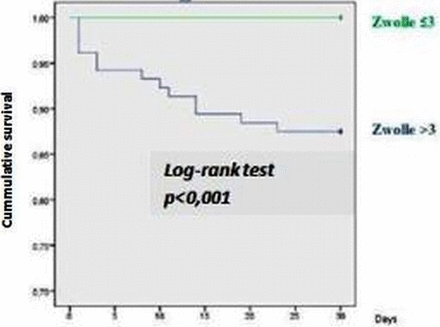-
Views
-
Cite
Cite
A. Tralhao, S. Madeira, M. Borges Santos, I. Rosario, M. Castro, A. Miguel Ferreira, J. Ferreira, M. Trabulo, M. Mendes, Can we improve duration of hospital stay in angioplasty treated ST-segment elevation acute myocardial infarction? The Zwolle risk score, European Heart Journal, Volume 34, Issue suppl_1, 1 August 2013, P472, https://doi.org/10.1093/eurheartj/eht307.P472
Close - Share Icon Share
Purpose: Optimal duration of stay (DS) in angioplasty (PCI) treated uncomplicated acute ST-segment elevation myocardial infarction (STEMI) remains undetermined. The Zwolle risk score (ZRS) is a simple tool which could help identify patients who can be safely discharged before 72h. We aimed to apply ZRS to our population and assess the variables influencing DS.
Methods: 276 consecutive STEMI patients admitted for PCI were studied, between January 2009 and December 2010. ZRS, DS and 30-day mortality were obtained for all patients. Low risk was defined as ZRS≤3 and ROC curves were used for discriminative power.
Results: In the 276 patients evaluated (mean age 62±13 years-old, 75% male, 20% Killip>1), ZRS median was 3 (IQR 1-4). 171 patients were classified as low risk. These patients were younger (57.1 vs. 67.6 years-old, p<0.001), less often hypertensive (46.8 vs. 67.6%, p=0.001), less often diabetic (14.6 vs. 27.6%, p=0.012) and had less frequently serum creatinine>1.2 mg/dL (37.2 vs 62.8% p=0.001). Total 30-day mortality was 4.7% (13 patients). ZRS correctly predicted this event in 93.7% of cases (C-statistic 0.937; CI95% 0.906-0.968). 30-day mortality, stratified by ZRS, was significantly different in the 2 groups (0 vs. 12.4% p<0.001, Fig.1), corresponding to a positive predictive value of 100% (CI95% 97.0-100%) for safe early discharge. In the low risk subset of patients, mean duration of stay was substantially lower (6.0 vs. 15.1 days, p<0.001). The need for additional revascularization (20 patients, 11.7%) was the most frequent cause for longer DS.

Figure 1
Conclusions: In our population, a ZRS ≤3 had both high discriminative power and positive predictive value for safe early discharge, translating on the DS. A cost-benefit analysis is warranted to further assess the real impact of these results.





